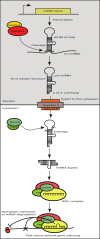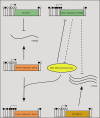MicroRNAs in cancer treatment and prognosis
- PMID: 22860232
- PMCID: PMC3410578
MicroRNAs in cancer treatment and prognosis
Abstract
Disturbances in microRNA expression by epigenetic alterations and mutations may promote not only tumorigenesis but also tumor aggressiveness, invasion, metastasis, and resistance to chemotherapy and radiotherapy. Several studies have profiled microRNA expression in normal and tumorigenic tissues, demonstrating a unique microRNA signature, which can be used as a marker for cancer diagnosis and prognosis. This review discusses the importance of microRNAs as regulatory biomolecules involved in cancer, focusing on microRNAs related to cancer invasion, metastasis, epigenetic alterations, chemoresistance, and radioresistance. The identification of both differentially expressed microRNAs in tumors and their target genes provides new tools for gene therapy; the re-expression of microRNAs silenced by cancer development or the silencing of oncogenic microRNAs can be effective in the blockade of cancer-related cell proliferation.
Keywords: MicroRNA; chemotherapy; epigenetic modifications; metastasis; radiotherapy.
Figures



References
-
- Lee RC, Feinbaum RL, Ambros V. The C. elegans heterochronic gene lin-4 encodes small RNAs with antisense complementarity to lin-14. Cell. 1993;75:843–854. - PubMed
-
- Wightman B, Ha I, Ruvkun G. Posttranscriptional regulation of the heterochronic gene lin-14 by lin-4 mediates temporal pattern formation in C. elegans. Cell. 1993;75:855–862. - PubMed
-
- Zhao Y, Srivastava D. A developmental view of microRNA function. Trends Biochem Sci. 2007;32:189–197. - PubMed
-
- Bartel DP. MicroRNAs: genomics, biogenesis, mechanism, and function. Cell. 2004;116:281–297. - PubMed
LinkOut - more resources
Full Text Sources
Other Literature Sources
